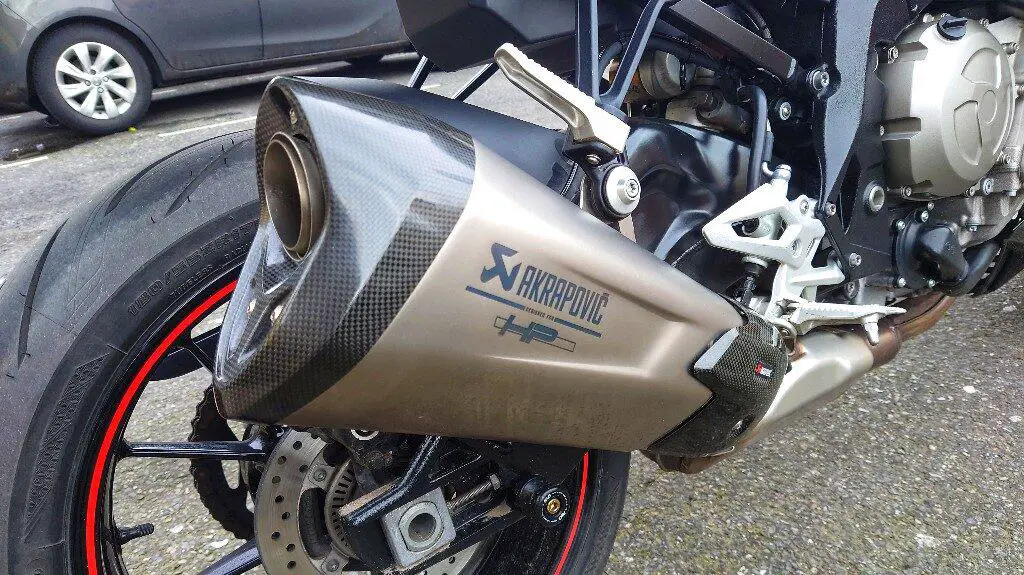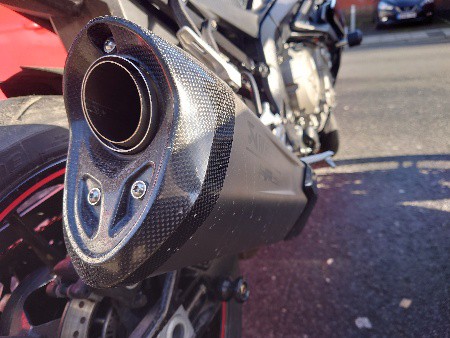
A baffle is a specific part inside the exhaust pipe that slows down exhaust gas flow before leaving the exhaust pipe. This lessens the motorcycle engine’s noise level and also creates “back pressure” inside the system.
Removing baffles on your motorcycle will not directly harm or damage the engine. However, it may result in the engine running leaner, causing a problem with its performance and complications to the emissions. Removing the baffle does not add any performance benefit or enhancements to the engine.
In many places, riding without a muffler is illegal. So it is not common for motorcycles to operate without them. It is mainly done for aesthetic purposes or reclaiming the motorcycle engine’s natural loud volume for those who can and desire to remove the baffles on their exhaust pipes.
The baffles and the interior diameter of this part of the exhaust are where the engine’s sound is modified, and many riders remove the baffles when they take their motorcycles out on track days if their exhaust pipe is designed for this.
What Is The Purpose Of Baffles On A Motorcycle?
Exhaust baffles are metallic chamber parts that are acoustically tuned and fit onto the exhaust pipe’s muffler. They function to cancel out or muffle the loud noise created from the exhaust pipe.
Most motorcycles come with a standard baffle or muffler required by law to reduce the engine’s natural noise levels. Removing the baffle will cause the exhaust to become freer flowing and release the exhaust gases quicker, making the bike louder.
The Pros And Cons Of Baffles On A Motorcycle
Pros
Noise Reduction
The primary purpose and use of baffles are to reduce the motorcycle engine’s noise volume through the exhaust pipe. Baffles reduce and dampen the overall engine volume.
The loud engine noises can be considered a disturbance to neighboring areas or people. Most countries have governmental laws to ensure certain noise capacity limits from vehicles are not exceeded. The baffles in a motorcycle’s exhaust are primarily used to prevent this excess noise pollution and help riders uphold the law while still enjoying their motorcycles.
Minimal Maintenance
Motorcycle baffles are simple parts that are easily constructed with a minimalistic design. They do not need much maintenance, and they have a long-lasting service life.
The baffle within a motorcycle’s exhaust is not expensive and not a piece that is frequently replaced or repaired.
Cons
Back Pressure
The build-up of additional pressure, also known as back pressure, leads to a reduction of horsepower output and limits the torque, increasing strain on the motorcycle engine.
The combustion of fuel in the engine develops into exhaust gases as by-products. These gases are propelled into the exhaust pipe and released through the exhaust muffler and baffles.
Increased back pressure caused by baffles is the main disadvantage to having one attached to your exhaust. This increase in back pressure may affect the engine’s performance, causing a change to the air-to-fuel ratio, causing the motorcycle engine to run richer. When an engine runs richer, it may cause a problem with its performance and cause complications to the emissions.
Leakage
Exhaust baffles have the potential of deteriorating because of wear and tear and their exposure to the heat and the gases from the exhaust pipe. This deterioration can cause what is called leaking in the exhaust baffle.
Leaking can create an annoying rattling sound when riding the bike. Exhaust baffles cannot be repaired and will need to be replaced entirely. This increases the maintenance costs of the motorcycle. However, new replacement baffles are relatively inexpensive.
What Happens When You Remove The Baffles?
The first and most evident change that will occur when removing the baffles off the exhaust pipe is that the bike will become distinctly louder. The noise volume of the bike will increase, and the sound of the engine will change.
Many fellow motorcyclists believe that a louder motorcycle is a safer motorcycle, and I discuss this in my article Are Loud Motorcycles Really Safer? You will also find a list of motorcycle noise limits on a state-by-state basis.
Alternatively, you can click HERE, and you will be taken to the Digest Of Motor Laws Website, where you can also view this information.
The engine may sound much deeper and more aggressive than when the baffles are attached. This change in the sound is the main reason most riders remove the baffles from the exhausts within their motorcycles.
In most urban areas, removing the baffles will put you in violation of most federal and local noise restrictions or requirements.
Baffles are added to the exhaust to reduce the number of gases released at one time and reduce the rate at which gases are dispersed from the bike. Removing the baffles can also put the motorcycle owner in violation of emissions regulations for motorcycles and vehicles in some countries.
There have been rare cases when a rider uses the motorcycle for long periods without switching off the engine and has removed the baffles. The exhaust valves and seats have been damaged due to the heat and lack of protection.
Motorcycle testing on bikes with baffles and without baffles has shown no noticeable or significant change in the performance level of the motorbike when removing the baffles.
Taking Off Exhaust Baffles
It is important to note that attempting to remove baffles without the relevant knowledge, skills, tools, and experience can damage your bike or yourself.
It is essential always to remember to make sure the bike is completely cooled down before working on it. If the exhaust is still hot, you can end up burning yourself very badly.
You will need the correct tools to remove the baffles without causing any damage safely. You will most likely need tools like socket wrenches and crescent wrenches, and some old rags to prevent oil from harming the muffler’s finish.
You will want to make sure that you have someone skilled and with experience with you when you remove the baffles, or you will need to have done the necessary research and follow the steps correctly.
It is advised that you have your owner’s manual with you and have a clear understanding of your bike and its design and model.
Replacing motorcycle parts should be done with caution and wisdom. It is a good idea to be thoroughly prepared and equipped to do the job correctly for your own safety.
It will be beneficial to contact your bike manufacturer to ask the relevant questions and make sure you are fully aware of any model specifications or design differences from other bikes before following a guideline from the internet, for example.
Can You Put Baffles Back On The Exhaust After Removing Them?
Some after-market exhaust pipes are designed so that it is easy to remove and replace the baffles. However, if this isn’t the case, it isn’t easy to put them back on once you have removed the baffles. Instead, it is recommended to use a qualified mechanic allowing the baffles to be correctly installed once again.
The process of removing the baffles is not a simple unclipping or slipping off the part. It requires the correct tools and some work to remove them. It is essential to be aware of small mistakes that can damage the baffles’ finish or the mid-pipe or head-pipe.
Can Aftermarket Mufflers Increase Exhaust Volume?
One of the standard solutions to increase the exhaust volume on a motorcycle but maintain regulations and the motorcycle’s health is to convert to an aftermarket muffler, also known as a slip-on.
The muffler on a motorcycle is the larger part of the exhaust which connects to the exhausts midpipe.
There are different makes and brands of mufflers. It is essential to understand your motorcycle’s engine and exhaust configuration when choosing a slip-on muffler. Selecting the correct muffler for your bike will ensure that you purchase the proper fit and operate will best according to your bike.
Slip-on mufflers are a cheaper and more user-friendly way of replacing stock baffles with something that fits your requirements and desired adjustments. Some aftermarket mufflers offer more volume and engine noise without breaking the noise pollution laws or regulations.
The installation of slip-on muffles is a simple process. Most aftermarket mufflers come with a basic installation kit with all the tools and parts needed to carry out the operation.
Aftermarket mufflers do not offer any enhancements to the performance worthy of mention as they will not give the engine much boost in horsepower and the weight reduction is also minimal as the rest of the exhaust remains stock; however, they are the best way for a rider to customize their bike according to their preferences, affordably and legally.
Another benefit of aftermarket mufflers is that there will not be any need to adjust the air-to-fuel mixture, saving a lot of time and possibly money if you have to get the engine re-tuned by a specialist mechanic.
You will also be able to pick and choose one that best suits the aesthetic style and design that you prefer. There are many designs and styles on the market which give varying options of look and feel.
Summary
It is widespread for motorcycle lovers to lean towards the preference of a loud and pure engine tone that most baffles or mufflers suppress. Many riders believe that the louder engine volumes help bring more awareness to motorcycles on the road and cause people to pay attention.
Despite these valid points, some laws and regulations limit the freedom of riding without baffles and mufflers in most urban areas. Exhaust baffles reduce noise pollution and emissions and enable riders to ride in their local neighbourhoods and cities without causing too much noise pollution.
Removing baffles from your motorcycle will do no long-term damage or harm to your bike and offers no performance enhancement benefits. It can contribute to a more preferred aesthetic appeal and engine volume, and those are the main reasons for making the change.






